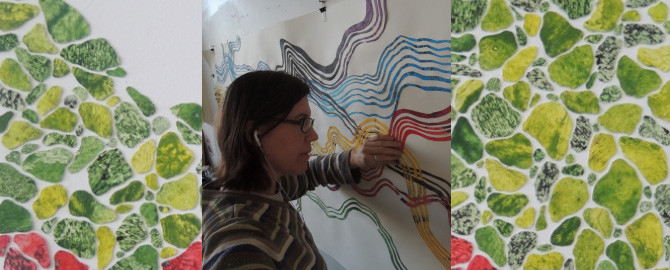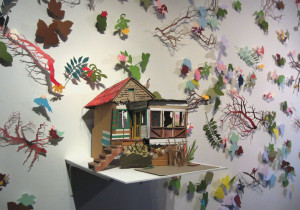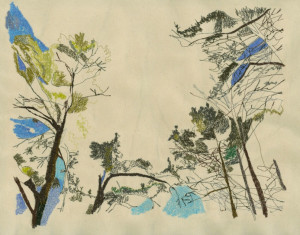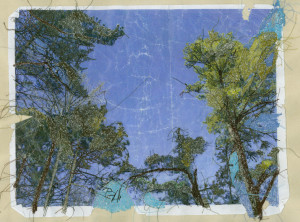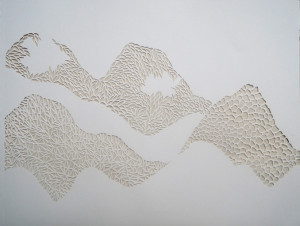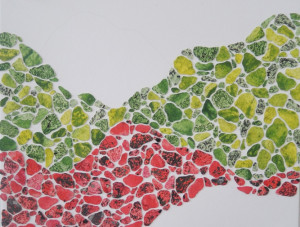Sophia Allison creates collages, mixed media drawings, sewn works and sculptures that loosely reference abstracted aspects of nature inspired by the mountainscapes she sees from her studio window in downtown Los Angeles and the variations of flora and vegetative color around her neighborhood. She is co-founder and co-directorof ShoeboxLA with artist Paul W. Evans, now in its third year.
Could you please introduce yourself and tell us a bit about your background and how you became an artist.
My name is Sophia Allison and I live in Los Angeles with my husband and 3-year old daughter. I have been interested in making art for as long as I can remember. I was fortunate that my family was supportive of this when I was young; my mom likes to tell an anecdote of how she let 3-year old me draw a “mural” on the outside of our apartment walls. I’m sure the neighbors were amused but the landlord wasn’t. I have pretty much stayed a messy maker of stuff every since. I went to graduate school studying and producing painting and drawing, but I later became interested in creating art from found and domestic materials and taught myself how to sew and construct works from non-traditional art materials.
Where do you get your inspiration from? What, or who inspires you the most?
For the past few years, I came to realize that much of my work was and is about the physical and emotional landscape of my childhood–western North Carolina and the Blue Ridge mountains. My family owns a large piece of property there with a small campground and cottage business called “Red Gates.” They get their customers pretty much by word of mouth and some of the family actually lives on the property. I stayed there for prolonged periods as a child until my parents bought a house, just a mile down the road. The place hasn’t changed that much since I was a kid. During the past few years, I started documenting some of the older worn buildings and natural vegetation overgrowth. I used these images in the sewn works I started making around 2009.
The sewn works I call “pictorials”-they are mainly sewing but have a bit of collage in them due to the paper used on the fabric. To create these works, I place a printed image on fabric and repetitively sew through the paper, forcing it into the cloth fibers while simultaneously destroying the paper. Parts of the image are recreated with thread on the opposite side of the material. The effect is two-fold: on one side, the landscape is clearly articulated; on the other, the paper image is obliterated, leaving loose threads and uneven textures. The image is simultaneously destroyed and built up; it is recognized as a snapshot of a specific location and at the same time it becomes fragmented and abstracted. The works are hung so the viewer can see both the front and back sides. In my current work, I combine aspects of of North Carolina’s landscape with the landscape I see around my neighborhood in Los Angeles. I live in a walkable place so I can see first hand the subtle changes of seasons and vegetation. Additionally, I can see a wonderful mountain range from my studio in Downtown LA. Much of the current work I am doing now is more abstract but I still draw inspiration from these landscapes.
You started your art career by studying Painting. How do you feel that this informs the work that you do with textiles? Why did you make this transition from Paint to Textiles?
Yes, I definitely feel that aspects of painting come through the sewn works. Before I started the sewn pictorials, I hadn’t painted in a while and had been manipulating found paper through sewing and collage processes. In fact, when I started making the pictorials, I was interested in incorporating color and mark-making much like the actions in painting and drawing. My sewing machine has about 25 stitches-it’s a basic Kenmore machine from Sears that I purchased for under $100. It’s not a programmable sewing machine so I get to physically push, pull and manipulate the fabric back and forth, trying to create a variety of marks through the limited stitches of the machine. Often I’ll “mix” colors by using different colored threads through 2 spools and the bobbin. I enjoy having some control over how the stitch lands. More recently, I’ve been experimenting with hand sewing on an image in addition to machine sewing.
You work with other artists, collaborating on pieces. What would you say were the benefits of working like this?
The collaborations have really given me great energy and ideas I may not have hit upon by working alone. The artists and I were friends first so much of the collaborations came as a natural outgrowth of talking about and looking at art together. Also, we were lucky to have had opportunities to have exhibited these collaborations publicly (at the Craft and Folk Art Museum, Los Angeles International Airport and other locations around Los Angeles) -in this way, the works seemed to get another life beyond our excitement for the making and producing of it together in a studio situation. This led to other opportunities to work together as well as to create a larger network with other artists, which is always a good. Through collaborations, I get introduced to new ways of thinking, making and looking at art which of course helps and inspires me when I go back to the studio to do solo work.
One of my most recent collaborations though, has been curatorial. Artist and friend Paul Evans and I have been curating a tiny pop-up gallery called ShoeboxLAhttp://www.shoeboxla.blogspot.com/. We had a total of 18 exhibitions and hosted them in our tiny gallery space at different locations around east Los Angeles. Our first space measured 18″ x 24″ x 8″ -the walls were magnetic so they were easily movable, and we could set up however the artists needed for their exhibition- and the 2nd year, we had another small gallery built which measured 24″ x 30″ x 8″. The whole install and deinstall process took maybe 5-20 minutes and the shows lasted for a total of 3 hours. It was great as we had some spectacular LA artists take on the challenge of creating work for our tiny space. We didn’t specialize in miniature work but more specifically, site-specific work created just for the duration of the exhibition. We created a catalog of our first year of shows through a successful kickstarter campaign. We had a great response from the art community and from the public. We got a little press too, which never hurts. Some of our more memorable press was a mention in Huffington Post’s Top Ten Art Galleries in Strange Places and the LA Weekly’s10 L.A. Art Spaces That Change Our Idea of What an Art Space is. ShoeboxLA was a good lesson for me to see what it was like to curate and work with other artists in this capacity. We’ve been working on doing web-only shows through a side project (connected to ShoeboxLA) calledhttp://shoeboxla.com/. •
What concepts are you currently exploring and what will you embark on next?
I have been working with paper for a while and more recently I am painting sheets of watercolor paper-front and back-and letting it dry on my studio floor. After it dries, I lift it up and the paint picks up the dust, grime and dirt from the studio floor creating a kind of terrain-like texture on the surface. I cut up the paper to create collage works that reference landscapes in an abstracted way. Currently, I am also cutting a few thousand flower shapes (that reference flora both in Los Angeles and western North Carolina) to create a hanging installation. I’ve always wanted to have some kind of garden in the studio but I don’t have a green thumb.
I’ve created paper floral installations before, but these were wall bound, and I want something that will have more freedom, that viewers can walk under. I’ve also been thinking of flying carpets, so I’m imagining all of these flower shapes impaled on rods that can be hung from the ceiling. The rods can be positioned in different ways, so the installation will look like its rippling, undulating creating a sense of movement through space. I think the rods will be hung by colored string or threads on either end (the same color as the rods and flowers) so the actual mechanics of the installation will become part of the work also and in some small way, through using the strings, a nod to sewing will be included.
In 2001 Allison graduated with a MFA from the University of Wisconsin-Madison. Her work has been written about and included in several publications such as Make magazine, Artillery Magazine, the Los Angeles Times and New American Paintings
All images courtesy of Sophia Allison | www.sophiaallison.com
For more information on Hong Kong Art Tutoring please contact:
Gail Deayton
Telephone: +852 9722 8353
Email: gd@gaildeayton.com

